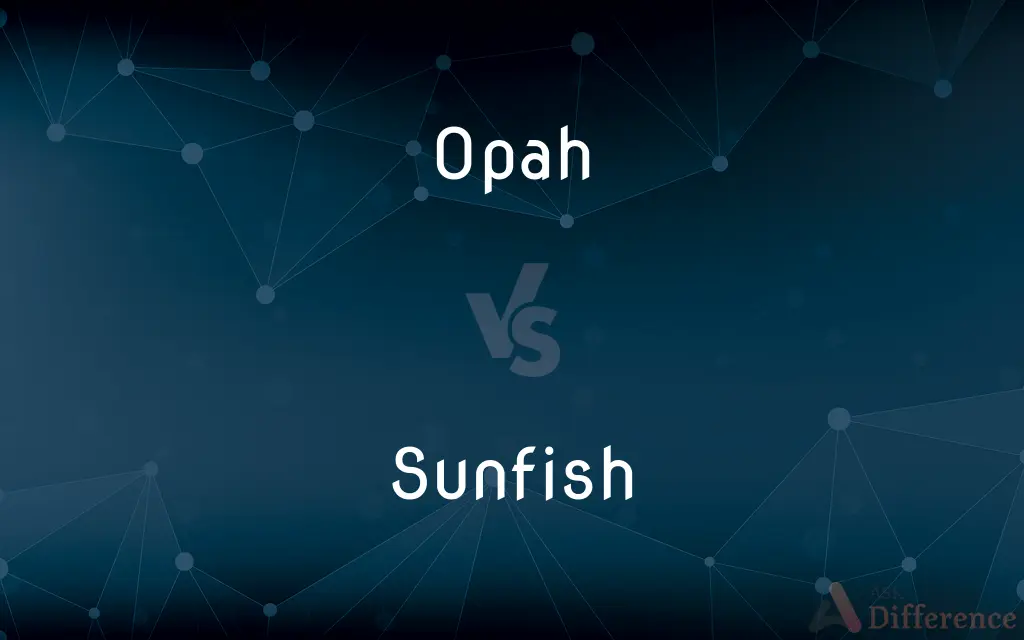Opah vs. Sunfish — What's the Difference?
By Fiza Rafique & Maham Liaqat — Updated on April 1, 2024
Opah, also known as moonfish, are deep-sea fish known for their round, flat bodies and vibrant colors, capable of warming their blood. Sunfish are heaviest bony fish, recognized for their odd shape and immense size, primarily dwelling in warmer oceans.

Difference Between Opah and Sunfish
Table of Contents
ADVERTISEMENT
Key Differences
Opah are unique among fish for their ability to internally generate heat, allowing them to inhabit cold, deep waters worldwide. They have a distinctive appearance with a round, flat body and bright coloration, including spots and shades of red and orange. This endothermic ability helps them move quickly and hunt in the chilly depths. Whereas sunfish, known for their unusual appearance, have a flattened body and are often seen basking in the sun near the ocean's surface. They feed on jellyfish and can grow to an enormous size, making them a fascinating sight in temperate and tropical waters.
The diet of an opah is varied, consisting of squid, small fish, and crustaceans. Their ability to warm their blood enables them to dive to significant depths in search of food. On the other hand, sunfish primarily consume jellyfish, supplemented by small fish, plankton, and algae. Despite their size, their diet is relatively low in nutrients, which is why they are often seen consuming large amounts of jellyfish to sustain themselves.
Opah's reproduction involves the release of eggs and sperm into the water, where fertilization occurs externally. Little is known about their breeding habits due to their deep-water habitats. In contrast, sunfish also reproduce by releasing eggs into the water, but they are prolific breeders, with females capable of producing millions of eggs at a time, ensuring the continuation of the species despite predators.
Conservation status varies between the two, with opah not currently listed as endangered but facing threats from commercial fishing practices. The sunfish, while not extensively targeted by fisheries, faces threats from bycatch, plastic pollution, and being struck by boats, with some species of sunfish considered vulnerable.
In terms of human interaction, opah are becoming increasingly popular in seafood markets due to their rich, flavorful meat, which is considered a delicacy in some cultures. Sunfish, however, are not commonly eaten due to their gelatinous flesh but are popular attractions for divers and marine tourists in regions where they are commonly found.
ADVERTISEMENT
Comparison Chart
Habitat
Deep, cold waters globally
Temperate and tropical oceans
Appearance
Round, flat body with bright colors
Large, flattened body, odd shape
Diet
Squid, small fish, crustaceans
Jellyfish, supplemented by small fish and algae
Reproduction
External fertilization, details largely unknown
External fertilization, females lay millions of eggs
Conservation Status
Not listed as endangered, but affected by fishing
Vulnerable to bycatch, plastic pollution, and boat strikes
Human Interaction
Increasingly popular in seafood markets
Not commonly eaten, but a draw for marine tourism
Compare with Definitions
Opah
A deep-sea fish known for its unique ability to warm its blood.
The opah uses its warm-blooded advantage to hunt in the cold depths.
Sunfish
The heaviest of the bony fish, known for its immense size.
Sunfish can weigh over two tons, making them giants of the sea.
Opah
Features a round, colorful body, making it distinctive.
The vibrant colors of the opah make it a favorite among deep-sea photographers.
Sunfish
Capable of producing millions of eggs.
A single sunfish can ensure the next generation with its prolific breeding.
Opah
Becoming a delicacy in some cultures.
Opah meat is prized for its flavor in fine dining.
Sunfish
Recognized by their peculiar shape and large dorsal fins.
The sunfish's odd shape often surprises first-time observers.
Opah
Not widely known for its reproduction methods.
Scientists are studying opah to understand more about their breeding practices.
Sunfish
Feeds mainly on jellyfish, requiring large quantities.
Sunfish consume countless jellyfish to sustain their massive bodies.
Opah
Consumes a varied diet, aiding its survival in deep waters.
The opah's diet includes squid, which it hunts in the chilly depths.
Sunfish
Attracts divers and marine enthusiasts.
Divers flock to areas where sunfish are known to bask in the sun.
Opah
Opahs, also commonly known as moonfish, sunfish (not to be confused with Molidae), kingfish, redfin ocean pan, and Jerusalem haddock, are large, colorful, deep-bodied pelagic lampriform fishes comprising the small family Lampridae (also spelled Lamprididae). The family comprises two genera: Lampris (from the Ancient Greek λαμπρός : lamprós, "brilliant" or "clear") and the monotypic Megalampris (known only from fossil remains).
Sunfish
Any of various North American freshwater fishes of the family Centrarchidae, having laterally compressed, often brightly colored bodies and including the crappies, black bass, bluegill, and pumpkinseed.
Opah
A large, oval-shaped fish (Lampris guttatus) having a silvery iridescent body with red fins and edible red flesh. Also called moonfish.
Sunfish
Any of several large marine fishes of the family Molidae, especially the ocean sunfish.
Opah
Any of various large, colourful, deep-bodied pelagic fish of the family Lamprididae.
Sunfish
Any of various small freshwater fishes of the family Centrarchidae, often with iridescent colours and having a laterally compressed body.
Opah
A large oceanic fish (Lampris guttatus), inhabiting the Atlantic Ocean. It is remarkable for its brilliant colors, which are red, green, and blue, with tints of purple and gold, covered with round silvery spots. Called also king of the herrings.
Sunfish
Any of various large marine fishes of the family Molidae that have an oval compressed body.
Opah
Large elliptical brightly colored deep-sea fish of Atlantic and Pacific and Mediterranean
Sunfish
(intransitive) Of an animal such as a bull or a horse: to twist the body into a crescent shape and roll back and forth.
Sunfish
A very large oceanic plectognath fish (Mola mola, Mola rotunda, or Orthagoriscus mola) having a broad body and a truncated tail.
Sunfish
The lean flesh of any of numerous American perch-like fishes of the family Centrarchidae
Sunfish
Among the largest bony fish; pelagic fish having an oval compressed body with high dorsal and anal fins and caudal fin reduced to a rudder-like lobe; worldwide in warm waters
Sunfish
Small carnivorous freshwater percoid fishes of North America usually having a laterally compressed body and metallic luster: crappies; black bass; bluegills; pumpkinseed
Common Curiosities
How do sunfish manage to eat enough jellyfish to sustain themselves?
Sunfish consume large amounts of jellyfish, compensating for the low nutritional value with volume.
Why aren’t sunfish more commonly eaten?
Despite their size, sunfish are not commonly eaten due to their gelatinous flesh, which is not favored in most culinary traditions.
What challenges do researchers face in studying these fish?
The deep-water habitat of opah and the vast, open-ocean roaming of sunfish make them challenging subjects for in-depth study.
Are opah targeted for their meat?
Yes, opah are increasingly sought after for their flavorful meat, becoming more common in seafood markets.
How do the reproductive strategies of opah and sunfish differ?
While both use external fertilization, sunfish are known for their enormous egg production, a contrast to the less understood reproductive habits of opah.
Can sunfish defend themselves against predators?
Sunfish rely on their size and speed to escape predators; however, their young are more vulnerable.
How do opah and sunfish interact with their environments?
Opah are active predators, using their warm blood to hunt in the cold depths, while sunfish are more passive, often basking in the sun near the surface.
Are there any specific regions where opah or sunfish are more common?
Opah are found in deep waters worldwide, while sunfish prefer temperate and tropical regions.
Why is the opah considered unique among fish?
Opah is unique due to its ability to warm its blood, a rare trait that allows it to thrive in cold, deep waters.
What conservation efforts are in place for these fish?
Conservation efforts for sunfish include addressing threats from bycatch, plastic pollution, and habitat destruction. For opah, managing fishing practices is key to their conservation.
Share Your Discovery

Previous Comparison
Disposed vs. Disposer
Next Comparison
Stamp vs. TampAuthor Spotlight
Written by
Fiza RafiqueFiza Rafique is a skilled content writer at AskDifference.com, where she meticulously refines and enhances written pieces. Drawing from her vast editorial expertise, Fiza ensures clarity, accuracy, and precision in every article. Passionate about language, she continually seeks to elevate the quality of content for readers worldwide.
Co-written by
Maham Liaqat














































